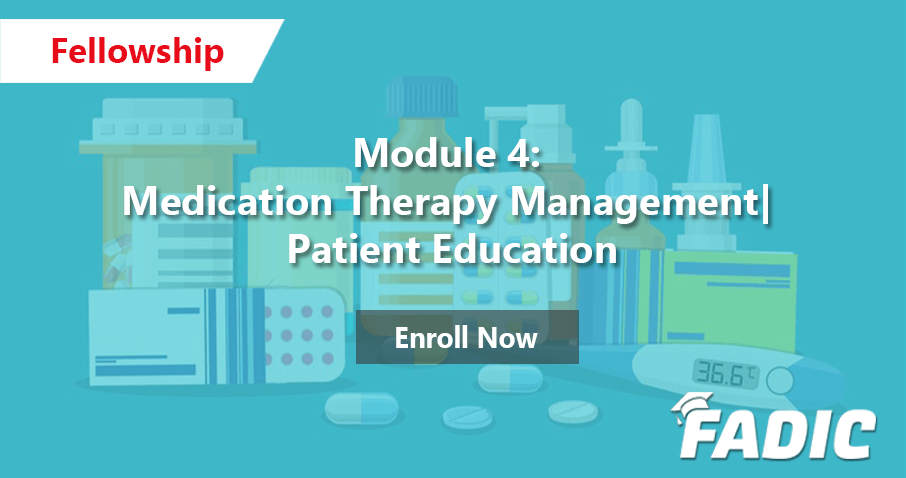
Overview
Module 4: Medication Therapy Management and Patient Education

Sessions Objectives
1. Comprehensive Medication Management – CMM and Medication Therapy Management
- Know more about medication therapy problems.
- Discuss the role of pharmacist in CMM.
- Define the CMM and how it is delivered.
- Understand the Barriers of CMM.
- Define the concept of medication adherence
- Identify potential barriers to adherence
- Define the concept of medication therapy management
- Recognize the role of pharmacists in improving medication adherence and improving the health care outcomes
2. General Guidelines for Patient Counseling
- Learn about Patient Counseling History & Definition
- Discuss Pharmacist and patient roles
- Learn more about Patient Counseling Steps
- Determine the useful links The Concept of patient-centeredness
- Steps during patient Counselling – Main Concepts?
- Topics commonly covered include.
3. Communication with CNS Mental Health Patients
By the end of this session, you will learn about:
- Depression treatment options and how to give counselling to your patient.
- Insomnia triggers and different treatment strategies.
- Anxiety treatment options and important information to give your patient.
- Headache and Migraine. different types, treatments, prevention strategies.
4. OTC Policy and Guidelines | Pharmacist as an OTC Prescriber
- Differentiate between prescription Vs. OTC drugs
- Know more about the OTC Policy and Guidelines among the global
- Understand the OTC Medication Safety Tips (Patient & Pharmacist)
- Learn how to ensure the safety of OTC products
- Learn how to teach patients “Medicines in My Home (MIMH)”
- Provide the List of OTC among the global, Educational Resources: OTC Medication, and Toolkits.
- Discuss the Pharmacist Role for Proper Patient Assessment AND OTC Selection.
- Discuss how Pharmacists maintain the proper selection and use of OTC products.
- Learn the Effective Practice of OTC Counseling
- Determine the 7 Steps to Consider in Clinical Reasoning
- Illustrate the OTC Differential Diagnosis – An Example
- Define How Pharmacist Become a Prescriber for OTC Medications in different disease specialties.
- Understand the systematic way of dealing with OTC Medications.
5. Top symptoms in the pharmacy Migraine and Headache
- Discuss the types and pathophysiology of headache.
- Determine the treatment approaches of migraine and headache.
- Evaluate the OTC medications that used in the management of headache.
- Describe important patient counseling key points needed to educate the patient.
- Evaluate the role of pharmacist on patients with headache and migraine.
6. Types of Vitamins and selection between them
- Understand the definition and types of vitamins.
- Define each type of vitamins, sources, deficiency, and toxicity.
- Determine how to maintain the best use of vitamins.
- Describe the role of pharmacist in use and recommendation of vitamins
- Illustrate how pharmacist promote vitamin patient counseling
- Discuss some case studies and how to use the proper approach in vitamin use.
7. Role of Pharmacist in Clinical Pharmacokinetic Monitoring
- Discuss the primary goal of pharmacokinetics.
- Determine the role of pharmacists in pharmacokinetics
- Define the PK responsibility of pharmacist
- Provide the steps of TDM needed for pharmacists
- Discuss FADIC Clinical Guide to apply pharmacokinetics
- Illustrate the PK training packet for pharmacists
8. Role of Pharmacist-led Pharmacotherapy
- Collaborates with other health professionals to make therapeutic decisions such as drug and drug product selection, therapeutic drug monitoring, and drug dosing.
- Participates in the planning and development of patient treatment.
- Investigates therapeutic alternatives and recommends or initiates management of patient-related problems based on interpretation of literature & clinical experience.
- Communicates the results of these investigations to health care practitioners in a manner appropriate to the training, skill, and need of that health professional.
- Assists in the management, monitoring, and modification of drug therapy in patients with chronic disease.
- Reviews patient records and orders regarding drug therapy and recommends and initiates changes as appropriate.
9. Pharmacokinetics and Pharmacodynamics for Clinician
- Describe Main Ideas of pharmacokinetics (PK) for Clinician and the clinical application of PK parameters in clinical practice.
- Describe physiologic factors and disease states that affect drug disposition.
- Describe pharmacodynamics (PD) and how to apply its principles to clinical practice.
10. UK Report for 2050 of Antimicrobial Resistance and Need for Antimicrobial Stewardship
- Learn about the impact of antimicrobial resistance on the world’s economy if the problem is not tackled.
- Learn How we can change our use of antimicrobial drugs to reduce the rise of resistance in genetics, genomics and computer science.
- Learn How we can boost the development of new antimicrobial drugs.
- Learn about the potential for alternative therapies to disrupt the rise in resistance.
- Learn about the need for coherent international action that spans drugs regulation, and drugs use
11. Upper Respiratory Tract Infection
- Design an appropriate treatment regimen for a patient with a Rhinosinusitis.
- Develop a definitive treatment plan for management of Group A Streptococcal Pharyngitis.
- Determine the treatment plan Influenza and Difference between Influenza and Cold.
12. Lower Respiratory Tract Infection
- Distinguish between the two main types of lower respiratory tract infection.
- Distinguish differences in 2005–2016 treatment guidelines for hospital-acquired pneumonia.
- Design an empiric treatment, according to type and severity of lower respiratory tract infection, for patients in the
inpatient and outpatient settings. - Justify the implementation of an antimicrobial stewardship program in managing lower respiratory tract infections.
13. Urinary Tract Infection
- Describe and define Urinary tract infections associated with the hospital setting
- Describe the epidemiology, microbiology, and treatment of the following:
o Acute cystitis
o Acute pyelonephritis
o Catheter associated UTI
o Asymptomatic bacteriuria
14. Skin and Soft Tissue Infections
- Describe pathophysiology / predisposing factors for tissue infections (SSTIs).
- Recognize clinical presentation and monitoring consideration.
- List primary pathogens associated with skin and soft tissues infections.
- Discuss appropriate antimicrobial therapy for SSTIs.
15. Multidrug-Resistant Organisms | Antibiotic Threads, Detection, Epidemiology, and Management
- Discuss the mechanisms of resistance behind common multidrug-resistant (MDR) pathogens.
- Determine Most common MDR Organisms.
- Discuss the mechanisms of resistance of common MDR.
- Describe the microbiology challenges associated with the identification of multidrug-resistant bacteria.
- Discuss the prevalence and epidemiology of multidrug-resistant bacteria.
- Describe the current evidence-based strategies in the management of invasive multidrug-resistant bacteria.
16. All What you need about the Vaccines
- Identify the type of immunity and vaccines?
- Discuss the vaccines route of administration, storage, adverse effects, contraindications and precautions.
- Determine the immunization schedules of CDC and Saudi MOH.
- Discuss the COVID-19 and Flu Vaccination.
- Identify the role of pharmacist in immunization.
- Determine the Vaccine Types
- Considerations When Scientists Create Vaccines
- The 4 Main Types of Vaccines
- Live Attenuated (viral and bacterial) Vs. Inactivated
- Live Vaccines are Used to Protect Against
Duration: 16 Weeks
-
W1- General Guidelines for Patient Counseling
- 1.1. Patient Counseling History and Definition (Video 14:45)
- 1.2. Pharmacist and Patient Roles (Video 10:00)
- 1.3. Patient Counseling steps (Video 14:36)
- 1.4. Useful Links (Video 12:51)
- 1.5. Patient Counseling Library (Books)
- 1.6. FADIC Prescriptions (Book)
- 1.7. Project 1 (Quiz 60:00)
-
W2- Comprehensive Medication Management – CMM and Medication Therapy Management
- 2.1. Comprehensive Medication Management (Video 18:47)
- 2.2. Medication Therapy Management (Video 20:21)
- 2.3. Pharmacist Role in Chronic Illness
- 2.4. Black Box Warning Medications List (Book)
- 2.5. Project 2 (Quiz 60:00)
-
W3- Communication with CNS Mental Health Patients
- 3.1. CNS Disorders and Depression (Video 31:43)
- 3.2. Insomnia Patient Counseling (Video 13:14)
- 3.3. Headaches Patient Counseling (Video 21:52)
- 3.4. Anxiety Patient Counseling (Video 10:13)
- 3.5. Epilepsy Patient Counseling (Video 27:21)
- 3.6. GAD & PD (Video 18:01)
- 3.7. PTSD and OCD (Video 23:02)
- 3.8. REMS in Psychiatry (Video 13:47)
- 3.9. Project 3 (Quiz 60:00)
-
W4- OTC Policy and Guidelines | Pharmacist as an OTC Prescriber
- 1.1. Prescription Drugs Vs OTC Drugs (Video 12:08)
- 1.2. FADIC E-library for OTC (Books)
- 1.3. OTC Regulations and Guidelines (Video 06:22)
- 1.4. The 10 Over-the-Counter Medication Safety Patients Tips (Video 11:39)
- 1.5. The 10 Over-the-Counter Medication Safety Pharmacist Prescribing Tips (Video 10:54)
- 1.6. Medicine in my home (Video 08:30)
- 1.7. The Safety of OTC Products (Video 08:49)
- 1.8. OTC Educational Resources (Video 07:03)
- 1.9. List of OTC Among the Global (Video 11:13)
- 1.10. Project 4 (Quiz 60:00)
-
W5- Top symptoms in the pharmacy Migraine and Headache
- 5.1. Pathophysiology of Headache (Video 08:24)
- 5.2. Treatment of Headache (Video 15:14)
- 5.3. OTC Oral Analgesics-NSAIDs-Acetaminophen- and Aspirin Selection (Video 09:47)
- 5.4. Assessment of Headache- A Case-Based Approach (Video 11:04)
- 5.5. Tension Type Vs Migraine Vs Sinus Headaches (Video 11:09)
- 5.6. The Role of Pharmacist with Headache Patient (Video 17:10)
- 5.7. Project 5 (Quiz 60:00)
-
W6- Types of Vitamins and selection between them
- 6.1. Types of Vitamins (Video 11:24)
- 6.2. Vitamin B1- B2- B3 (Video 14:23)
- 6.3. Vitamin B5 – B6 – B7 (Video 10:24)
- 6.4. Vitamin B9- B12- C (Video 15:23)
- 6.5. Vitamin A- D (Video 18:52)
- 6.6. Vitamin E-K (Video 13:26)
- 6.7. How Pharmacist use & Recommend Vitamins (Video 11:12)
- 6.8. Vitamin Patient Counseling & Education (Video 16:43)
- 6.9. Vitamin Case-Based Approach (Video 13:24)
- 6.10. Project 6 (Quiz 60:00)
-
W7- Role of Pharmacist in Clinical Pharmacokinetic Monitoring
- 7.1. Pharmacokinetics Vs. Clinical Pharmacokinetics (Video 09:40)
- 7.2. Rational Use of Drug Concentration Measurements (Video 11:02)
- 7.3. Evaluating the Need for a Drug Concentration Measurement (Video 07:41)
- 7.4. Approaches to Dosing With Limited Need For Drug Concentration Measurements (Video 12:45)
- 7.5. Role of Pharmacist in Clinical Pharmacokinetic Monitoring (Video 13:18)
- 7.6. Project 7 (Quiz 60:00)
-
W8- Role of Pharmacist-led Pharmacotherapy
- 8.1. What is Pharmacotherapy? (Video 03:59)
- 8.2. Heart Failure (Video 34:38)
- 8.3. Anti-arrhythmia (Video 28:41)
- 8.4. Coronary Artery Disease (Video 34:17)
- 8.5. Dyslipidemia (Video 24:23)
- 8.6. Hypertension (Video 17:23)
- 8.7. Diabetes (Video 01:15:13)
- 8.8. Pharmacotherapy in Special Populations (Video 14:07)
- 8.9. Role of Pharmacist-led Pharmacotherapy (Video 08:27)
- 8.10. Week 8 (Info-graphics)
-
W9- All What you need about the Vaccines
- 9.1. Vaccine Types: Inactivated Vs Live Attenuated (Video 26:48)
- 9.2. Vaccines: Contraindications & Adverse Effects (Video 18:00)
- 9.3. Active Vs Passive Immunity | Vaccines (Video 29:33)
- 9.4. Vaccines Storage (Video 15:29)
- 9.5. Vaccinations Needed Before You Travel & Hajj (Video 10:47)
- 9.6. Saudi MOH and CDC Immunization Schedules (Video 19:21)
- 9.7. Influenza Vs COVID-19 Vaccines (Video 38:40)
- 9.8. Pfizer-BioNTech COVID-19 Vaccine FAQs (Video 25:14)
- 9.10. Project 9 (Quiz 60:00)
-
W10- Final Project of Module 4
- 10.1. Final Project of Module 4 (Quiz 60:00)

 Log in
Log in Sign up
Sign up

